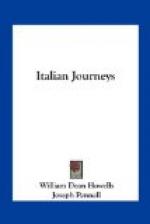In the evening we sat talking at the Caffe Pedrocchi with an abbate, an acquaintance of ours, who was a Professor in the University of Padua. Pedrocchi’s is the great caffe of Padua, a granite edifice of Egyptian architecture, which is the mausoleum of the proprietor’s fortune. The pecuniary skeleton at the feast, however, does not much trouble the guests. They begin early in the evening to gather into the elegant saloons of the caffe,—somewhat too large for so small a city as Padua,—and they sit there late in the night over their cheerful cups and their ices, with their newspapers and their talk. Not so many ladies are to be seen as at the caffe in Venice, for it is only in the greater cities that they go much to these public places. There are few students at Pedrocchi’s, for they frequent the cheaper caffe; but you may nearly always find there some Professor of the University, and on the evening of which I speak there were two present besides our abbate. Our friend’s great passion was the English language, which he understood too well to venture to speak a great deal. He had been translating from that tongue into Italian certain American poems, and our talk was of these at first. Then we began to talk of distinguished American writers, of whom intelligent Italians always know at least four, in this succession,—Cooper, Mrs. Stowe, Longfellow, and Irving. Mrs. Stowe’s Capanna di Zio Tom is, of course universally read; and my friend had also read Il Fiore di Maggio,—“The May-flower.” Of Longfellow, the “Evangeline” is familiar to Italians, through a translation of the poem; but our abbate knew all the poet’s works, and one of the other professors present that evening had made such faithful study of them as to have produced some translations rendering the original with remarkable fidelity and spirit. I have before me here his brochure, printed last year at Padua, and containing versions of “Enceladus,” “Excelsior,” “A Psalm of Life,” “The Old Clock on the Stairs,” “Sand of the Desert in an Hour-Glass,” “Twilight,” “Daybreak,” “The Quadroon Girl,” and “Torquemada,”—pieces which give the Italians a fair notion of our poet’s lyrical range, and which bear witness to Professor Messadaglia’s sympathetic and familiar knowledge of his works. A young and gifted lady of Parma, now unhappily no more, lately published a translation of “The Golden Legend;” and Professor Messadaglia, in his Preface, mentions a version of another of our poet’s longer works on which the translator of the “Evangeline” is now engaged.
At last, turning from literature, we spoke with the gentle abbate of our day’s adventures, and eagerly related that of the Ecelino prisons. To have seen them was the most terrific pleasure of our lives.
“Eh!” said our friend, “I believe you.”
“We mean those under the Villa P——.”
“Exactly.”
There was a tone of politely suppressed amusement in the abbate’s voice; and after a moment’s pause, in which we felt our awful experience slipping and sliding away from us, we ventured to say, “You don’t mean that those are not the veritable Ecelino prisons?”




